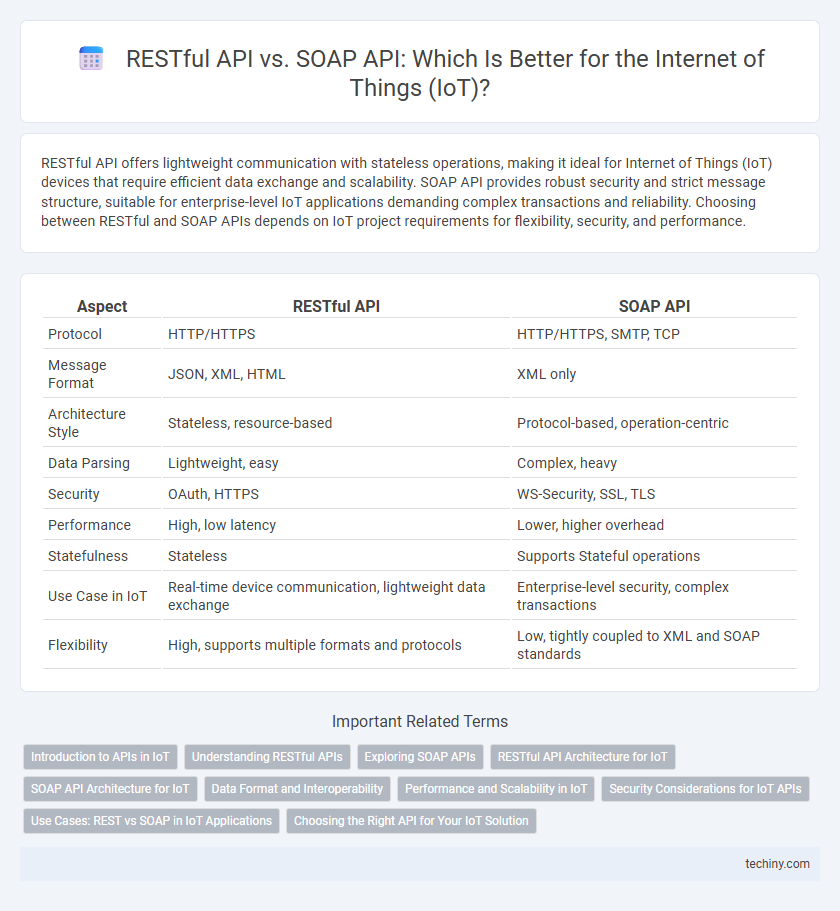RESTful API offers lightweight communication with stateless operations, making it ideal for Internet of Things (IoT) devices that require efficient data exchange and scalability. SOAP API provides robust security and strict message structure, suitable for enterprise-level IoT applications demanding complex transactions and reliability. Choosing between RESTful and SOAP APIs depends on IoT project requirements for flexibility, security, and performance.
Table of Comparison
| Aspect | RESTful API | SOAP API |
|---|---|---|
| Protocol | HTTP/HTTPS | HTTP/HTTPS, SMTP, TCP |
| Message Format | JSON, XML, HTML | XML only |
| Architecture Style | Stateless, resource-based | Protocol-based, operation-centric |
| Data Parsing | Lightweight, easy | Complex, heavy |
| Security | OAuth, HTTPS | WS-Security, SSL, TLS |
| Performance | High, low latency | Lower, higher overhead |
| Statefulness | Stateless | Supports Stateful operations |
| Use Case in IoT | Real-time device communication, lightweight data exchange | Enterprise-level security, complex transactions |
| Flexibility | High, supports multiple formats and protocols | Low, tightly coupled to XML and SOAP standards |
Introduction to APIs in IoT
RESTful APIs dominate IoT ecosystems by enabling lightweight, scalable communication between devices using standard HTTP methods, ideal for resource-constrained environments. SOAP APIs, while offering robust security and formal contracts through XML, pose overhead challenges unsuitable for many IoT applications. Efficient API selection enhances device interoperability and seamless data exchange critical for real-time IoT operations.
Understanding RESTful APIs
RESTful APIs in the Internet of Things enable seamless communication by using standard HTTP methods such as GET, POST, PUT, and DELETE, which simplifies integration with web services and devices. These APIs rely on stateless architecture and resource-based URLs, making them scalable and easy to maintain across diverse IoT environments. Compared to SOAP APIs, RESTful APIs offer lightweight data formats like JSON, reducing bandwidth usage and improving performance in constrained IoT networks.
Exploring SOAP APIs
SOAP APIs in the Internet of Things (IoT) provide robust security features such as WS-Security, supporting encryption and authentication protocols essential for sensitive data exchanges. They enable standardized messaging with XML-based envelopes, ensuring reliability and transactional integrity across diverse IoT devices and platforms. Although SOAP APIs are more complex and slower compared to RESTful APIs, their strict contract-based communication suits large-scale IoT systems requiring dependable message delivery and comprehensive error handling.
RESTful API Architecture for IoT
RESTful API architecture enables lightweight, stateless communication crucial for IoT devices with limited resources. Its use of standard HTTP methods and JSON format ensures seamless integration and real-time data exchange across heterogeneous IoT systems. REST's scalability and simplicity optimize device interoperability and efficient sensor data management in IoT ecosystems.
SOAP API Architecture for IoT
SOAP API architecture in IoT is designed around a rigid XML messaging protocol that ensures high security and standardized communication, making it suitable for complex device integrations. It relies on well-defined WSDL contracts enabling strict message structure validation, which enhances reliability in machine-to-machine interactions across diverse IoT environments. SOAP's support for WS-Security and transaction compliance is particularly beneficial in industrial IoT applications requiring secure, atomic operations and extensive error handling.
Data Format and Interoperability
RESTful APIs primarily use JSON as their data format, enabling lightweight and easy-to-parse communication ideal for IoT devices with limited resources. SOAP APIs rely on XML, which provides a more rigid and standardized structure, enhancing interoperability across diverse enterprise systems but increasing overhead. JSON's simplicity in RESTful APIs facilitates faster data exchange, while SOAP's XML ensures strict message validation and extensive protocol support, crucial for complex IoT environments demanding high reliability.
Performance and Scalability in IoT
RESTful APIs offer lightweight communication and stateless interactions that enhance performance and scalability in IoT devices with limited resources, enabling faster data exchange and lower latency compared to SOAP APIs. SOAP APIs, though robust and feature-rich with built-in error handling, tend to introduce higher processing overhead and larger message sizes, which can hamper efficiency in large-scale IoT deployments. The stateless nature of REST combined with support for caching mechanisms makes it more suitable for handling the massive volume and dynamic scaling required in IoT ecosystems.
Security Considerations for IoT APIs
RESTful APIs for IoT prioritize lightweight security protocols such as OAuth 2.0 and TLS to ensure efficient data encryption and secure access control, reducing latency in connected devices. SOAP APIs offer stricter security standards with WS-Security, supporting message integrity, encryption, and authentication suitable for mission-critical IoT applications requiring comprehensive security. Selecting between RESTful and SOAP APIs for IoT depends on balancing security needs with device constraints and network performance requirements.
Use Cases: REST vs SOAP in IoT Applications
RESTful APIs dominate IoT applications requiring lightweight communication, scalability, and low latency, such as smart home devices, sensor data collection, and real-time monitoring systems. SOAP APIs are preferred in industrial IoT scenarios demanding strict security, transactional reliability, and standardized messaging, including healthcare devices and financial service integrations. REST's stateless architecture supports rapid development and ease of integration, while SOAP's built-in error handling and WS-* standards suit complex, mission-critical IoT ecosystems.
Choosing the Right API for Your IoT Solution
RESTful APIs offer lightweight, stateless communication ideal for resource-constrained IoT devices, supporting JSON for faster data exchange and easier integration with web services. SOAP APIs provide robust security features and standardized protocols suitable for enterprise-grade IoT applications requiring reliable messaging and formal contracts. Selecting the right API depends on factors like device capabilities, network conditions, security requirements, and integration complexity within your IoT ecosystem.
RESTful API vs SOAP API Infographic

 techiny.com
techiny.com